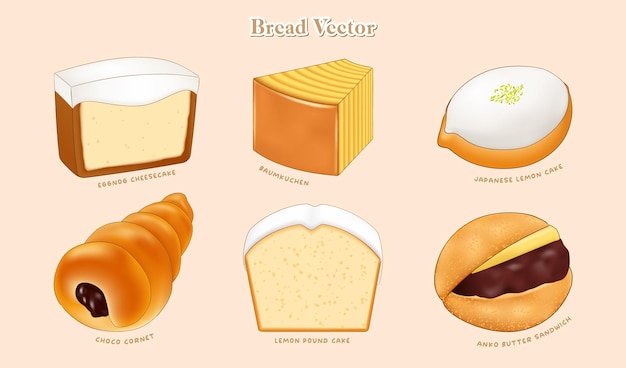Cafe Shop-- Kick Back and Enjoy Your Coffee at Our Cozy Cafe
Cafe Shop-- Kick Back and Enjoy Your Coffee at Our Cozy Cafe
Blog Article
From Sourdough to Croissants: Types of Breads and Pastries You Should Try
Exploring the varied globe of bread and breads exposes an elaborate tapestry of tastes and textures, each with its own special story. From the tasty complexity of sourdough, steeped in tradition and all-natural fermentation, to the improved flakiness of croissants, personifying French cooking proficiency, there is much to find. Think about the iconic baguette, with its crisp outside and ventilated crumb, or the buttery richness of brioche. Also the elaborate layers of Danish pastries, frequently filled with delicious custards or fruits, use a wonderful contrast. What makes each of these productions genuinely special? The solution exists just ahead.
Sourdough Bread
Sourdough bread, renowned for its distinct appetizing taste and chewy appearance, is a timeless standard that has actually been cherished for centuries. Stemming as a staple in ancient human beings, this artisanal bread owes its distinct features to the natural fermentation process including wild yeast and lactic acid microorganisms. The lack of business yeast enables for a slower fermentation, which boosts the depth of flavor and leads to an extra digestible loaf.
The standard method of making sourdough begins with a starter, a combination of flour and water that captures wild yeast from the environment. This starter is carefully maintained and fed regularly to keep the yeast and microorganisms active. When introduced to dough, the starter initiates fermentation, producing bubbles of co2 that give the bread its airy framework. The extensive fermentation duration not only improves the structure however also damages down gluten and phytic acid, making sourdough much more nutritious and easier on the digestive system.
Artisans globally take satisfaction in their one-of-a-kind sourdough dishes, each mirroring neighborhood ingredients and conditions - Lahore Bakery. Whether enjoyed plain, toasted, or as a foundation for exquisite sandwiches, sourdough bread continues to be an enduring icon of culinary workmanship and tradition

Baguettes
Though usually related to the culinary practices of France, baguettes have ended up being a cherished staple in bakeshops around the globe. Recognizable by their extended shape and crisp, golden-brown crust, baguettes are typically thought about the embodiment of easy, yet beautiful, bread-making (Cafe Shop). The origins of the baguette in its contemporary form can be mapped back to the early 20th century, when developments in baking modern technology enabled for the development of this distinct loaf
At its core, a standard baguette makes up just 4 components: flour, water, yeast, and salt. The mastery exists in the method. The dough undergoes a thorough process of massaging, proofing, and cooking, which leads to its characteristic appearance-- a thin, crackly crust wrapping up a soft, airy inside. This juxtaposition of textures is a specifying function that adds to the baguette's prevalent praise.
Baguettes are versatile and can be enjoyed in numerous ways. Whether cut and offered with butter, matched with cheeses and charcuterie, or used as the foundation for a sandwich, the baguette offers a delightful eating experience. This plain loaf showcases the beauty of simpleness, making it a long-lasting fave amongst bread enthusiasts globally.
Croissants
Distinguished for their buttery, flaky layers, croissants stand as a quintessential sign of French bread workmanship. Originating from Austria yet improved in France, croissants are a staple in patisseries and pastry shops worldwide (Lofology Bakery And Cafe). Their manufacturing includes a careful process called lamination, in which dough is folded up with butter several times to develop thin layers that puff up magnificently when baked
The key to a perfect croissant exists in the top quality of active ingredients and the precision of technique. The dough must be handled gently to keep the integrity of the layers, ensuring an airy, light inside.
Croissants can be appreciated plain or full of a variety of components such as almond paste, delicious chocolate, or pork and cheese, using convenience to fit various palates. Whether savored as a morning indulgence or an afternoon treat, croissants characterize the creativity of French cooking, making them a must-try for any culinary lover.
Brioche
Brioche's rich history and extravagant structure make it a standout in the world of bread and breads. Stemming from France, this pleasant, buttery bread days back to at the very least the 15th century and has actually considering that ended up being a symbol of extravagance and cooking finesse. Its name, acquired from the Old French term "brier," indicating to knead, highlights the significance of technique in its prep work.
The key to brioche's distinct character hinges on its enriched dough, which is packed with eggs and butter, causing a tender crumb and a golden, flaky crust. This high-fat material not only improves its flavor however also adds to its soft, pillowy texture. Brioche's convenience is one more factor for its widespread recognition. It can be delighted in plain, toasted with a touch of jam, or used as the base for more intricate developments such as brioche à tête, burger buns, and even bread dessert (Cafe Shop).
Regardless of its seemingly basic ingredients, the art of crafting an ideal brioche calls for precision and persistence. The dough undertakes a thorough process of working, relaxing, and proofing, ensuring that each loaf accomplishes its particular agility and richness. This commitment to high quality and practice cements brioche's condition as an ageless standard in the pastry shop repertoire.

Danish Breads

Danish pastries are celebrated for their versatility. They can be full of a variety of active ingredients, varying from wonderful to tasty. Classic dental fillings consist of custard, fruit protects, and almond paste. The addition of garnishes like nuts, icing, or fresh fruit commonly improves their visual appeal and taste profile.
The process of making Danish pastries needs accuracy. The dough should be maintained an optimum temperature to make certain the butter layers stay distinct, and the folding strategy requires a mindful hand to accomplish the excellent balance of flakiness and inflammation.
In the context of worldwide bread offerings, Danish pastries stand out not just for their meticulous workmanship but likewise for their capacity to give a wonderful burst of flavors and appearances in every bite (Lofology Bakery And Cafe). A real testament to the art of cooking, they remain a precious choice amongst pastry connoisseurs
Conclusion
The expedition of diverse bread and bread kinds, from the tangy deepness of sourdough to the buttery flakiness of croissants, reveals an abundant tapestry of cooking customs. The crisp crust and ventilated interior of baguettes, the lavish richness of brioche, and the detailed layers of Danish pastries filled up with custard or fruit highlight the artistry included in cooking. Each variety supplies a distinct sensory experience, emphasizing the significance of these baked items in worldwide culinary society.
Report this page